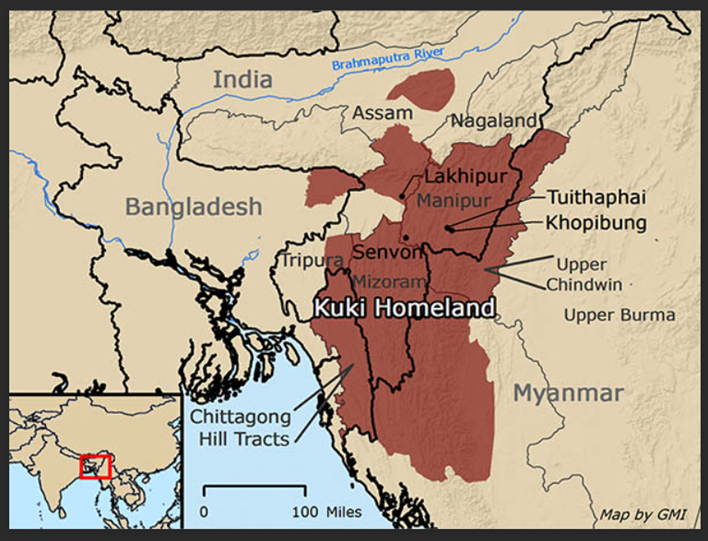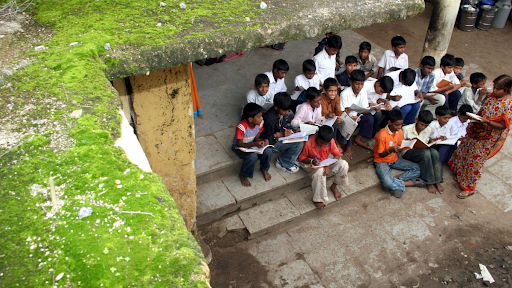Description

Copyright infringement not intended
Context: The recent violence in Manipur has raised serious questions about the validity and effectiveness of the ceasefire pact signed between the government and some Kuki militant groups.
Background
- According to reports, militants belonging to the Kuki National Army (KNA) and Zomi Revolutionary Army (ZRA), who are part of the Suspension of Operations (SoO) agreement, participated in a rally on May 3 and attacked Meitei villages, killing several civilians.
- This has sparked outrage among various student organisations, who have demanded that the Centre should scrap the pact and confiscate the weapons of the Kuki rebels. They have also urged for legal action against the perpetrators of the violence.
Suspension of Operations (SoO) agreement
- The SoO agreement was initiated in 2008 by the then UPA government, to resolve the long-standing issues of the Kuki-Chin-Mizo communities in Manipur.
- The agreement covers 25 insurgent groups, who are supposed to stay in designated camps and refrain from any unlawful activities.
- There have been allegations that some of these groups have violated the terms of the pact and indulged in extortion, intimidation, and land grabbing.
- There have been doubts about the nationality of some of the rebel leaders, especially those who have links with Myanmar.
- The Manipur government has recently decided to withdraw from the SoO agreement with KNA and ZRA, citing security and development concerns. The chief minister has met with the Union home minister to discuss the matter and seek his intervention.

Kuki Tribe
About
- It is one of the ethnic groups that inhabit the northeastern regions of India, Myanmar and Bangladesh.
- They are mainly found in the states of Manipur and Mizoram in India, Chin State in Myanmar, and Chittagong Hill Tracts in Bangladesh.
- They are also known as Chin or Mizo people, and they share a common ancestry and culture.
- They are part of the larger Zo people, along with the Chin and Mizo tribes.
- The Kuki tribe has a rich and diverse history, culture and tradition that reflect their adaptation to the hilly and forested terrain they live in.
- They speak various dialects of the Chin-Kuki-Mizo language family, which belong to the Tibeto-Burman branch of the Sino-Tibetan languages.
Challenges
- The Kuki tribe has a long history of migration and settlement in different parts of South Asia.
- The Kuki tribe has faced many challenges and conflicts in their history, such as the Kuki Rebellion (1917-1919) against British rule, the Kuki-Naga clashes (1960s-1990s) over land and identity issues, and the Kuki-Zomi ethnic violence (1997-1998) that resulted in displacement and loss of lives.
Political structure
- The Kuki tribe has a unique social and political structure that is based on clans, villages and chiefs.
- The clan is the basic unit of kinship and identity, and it is traced through the paternal line.
- The village is the primary unit of administration and governance, and it is headed by a hereditary chief who has executive, judicial and religious authority.
- The chief also owns all the land and resources of the village, and he distributes them among his subjects according to their needs and merits.
Living style
- The Kuki tribe follows a traditional way of life that is closely connected to nature and their environment.
- They practice jhum or shifting cultivation, where they clear patches of forest land by burning and growing crops such as rice, maize, millet, etc.
- They also hunt wild animals and collect forest products for their subsistence and trade.
- They keep domestic animals such as dogs, pigs, buffaloes, goats and poultry for food and ritual purposes.
- They live in bamboo houses that are built on stilts or platforms to protect them from floods and wild animals.
Culture
- The Kuki tribe has a vibrant culture that is expressed through their festivals, dances, music, art, crafts, folklore and literature.
- They celebrate various festivals throughout the year to mark important occasions such as harvests, seasons, births, deaths, marriages, etc.
- Some of the major festivals are Kut (post-harvest festival), Chavang Kut (autumn festival), Mim Kut (maize festival), etc.
- They perform various dances such as Lamkut (group dance), Chongloi (sword dance), Pheiphit (war dance), etc.
- They play musical instruments such as khuang (drum), gong (cymbal), tangkul (flute), etc.
- They produce art and crafts such as weaving, basketry, pottery, wood carving, etc.
- They have a rich oral tradition of folktales, legends, proverbs, riddles, songs, etc. that reflect their worldview and values.
Outside influence
- The Kuki tribe has also been influenced by external factors such as Christianity, education, modernization and globalization.
- Many Kukis have converted to Christianity since the arrival of missionaries in the late 19th century. Christianity has brought changes in their religious beliefs and practices, as well as their social norms and values.
- Education has opened up new opportunities for them to access higher learning and employment in various fields.
- Modernization has brought changes in their lifestyle and consumption patterns, such as using modern amenities and gadgets. Globalization has exposed them to new ideas and cultures from other parts of the world.
Social Structure
- The Kuki people have a hierarchical social structure based on clans and lineages. Each clan has its name and emblem and traces its origin to a common ancestor.
- The clans are further divided into sub-clans and lineages. The clan system regulates marriage alliances, inheritance rights and social obligations among the Kuki people.
- The Kuki society is also patriarchal and patrilineal, which means that descent and inheritance are traced through the male line. The eldest son inherits his father's property and status, while the youngest son stays with his parents and takes care of them.
- The Kuki villages are usually small and autonomous, each ruled by its chief or headman.
Religion
- The Kuki people have a varied religious backgrounds, as they have been influenced by different faiths over time. Traditionally, the Kuki people followed animism, which is a belief in the existence of spirits in nature and ancestors.
- They also practised rituals such as animal sacrifices, ancestor worship and festivals to appease their gods and spirits.
- With the arrival of Christian missionaries in the late 19th and early 20th centuries, many Kuki people converted to Christianity, especially Protestantism.
- Today, Christianity is the predominant religion among the Kuki people, with some significant minorities following animism or other faiths such as Judaism or Islam.

Challenges
Lack of recognition and representation
- Lack of recognition and representation in the political and administrative spheres.
- The Kuki tribe is divided into many sub-tribes, each with its dialect and identity. Some of these sub-tribes are recognized as scheduled tribes by the Indian government, while others are not.
- This creates a sense of marginalization and discrimination among the Kuki people, who often feel neglected and ignored by the state authorities.
- The Kuki tribe has been involved in various conflicts and movements for autonomy and self-determination, both within India and Myanmar.
- These conflicts have resulted in violence, displacement and human rights violations for the Kuki people, who have suffered from atrocities committed by both state and non-state actors.
Loss of their traditional culture and identity
- Another challenge faced by the Kuki tribe is the loss of their traditional culture and identity due to modernization and assimilation.
- The Kuki tribe has a distinctive way of life, based on their ancestral customs, beliefs and practices. They have a strong sense of community and kinship, which is reflected in their social organization, festivals and rituals.
- With the advent of education, urbanization and globalization, many Kuki people have migrated to cities and towns, where they have to adapt to new lifestyles and values.
- This has led to a gradual erosion of their cultural heritage and identity, as they face pressure to conform to the dominant norms and expectations of mainstream society.
Steps need to be taken
- The way forward for the Kuki tribe is to find a balance between preserving their culture and identity and embracing modernity and development.
- The Kuki tribe should strive to assert their rights and interests in the political and administrative domains, by seeking recognition, representation and empowerment.
- They should also engage in dialogue and cooperation with other ethnic groups, both within India and Myanmar, to resolve their conflicts peacefully and harmoniously.
- The Kuki tribe should celebrate and promote their culture and identity, by preserving their language, literature, art, music and folklore.
- They should also educate their younger generations about their history, traditions and values so that they can carry forward their legacy with pride and dignity.
Conclusion
- The Kuki tribe is one of the vibrant and resilient communities of India's northeast. They have contributed to the social, cultural, and political development of the region. They have also faced many challenges and hardships, such as displacement, violence, discrimination, and poverty. They continue to strive for their rights, dignity, and development in a changing world.
Must Read Articles:
Kuki Chin: https://www.iasgyan.in/daily-current-affairs/kuki-chins
Violence in Manipur: https://www.iasgyan.in/daily-current-affairs/violence-in-manipur
|
PRACTICE QUESTION
Q. Which of the following statements is incorrect about the Kuki tribe?
A) The Kuki tribe is one of the major ethnic groups in Northeast India, especially in Manipur, Nagaland and Mizoram.
B) The Kuki tribe has a matrilineal system of inheritance and succession.
C) The Kuki tribe practices jhum cultivation, which is a form of shifting agriculture.
D) The Kuki tribe has a rich oral tradition of folktales, songs and proverbs.
Answer: B
Explanation: The Kuki tribe follows a patrilineal system of inheritance and succession, where the eldest son inherits the property and the authority of the father. The matrilineal system is followed by some other tribes in Northeast India, such as the Khasi and the Garo.
|

https://timesofindia.indiatimes.com/city/imphal/seize-kuki-rebels-arms-withdraw-peace-pact-6-student-groups-to-govt/articleshow/100221382.cms?from=mdr











